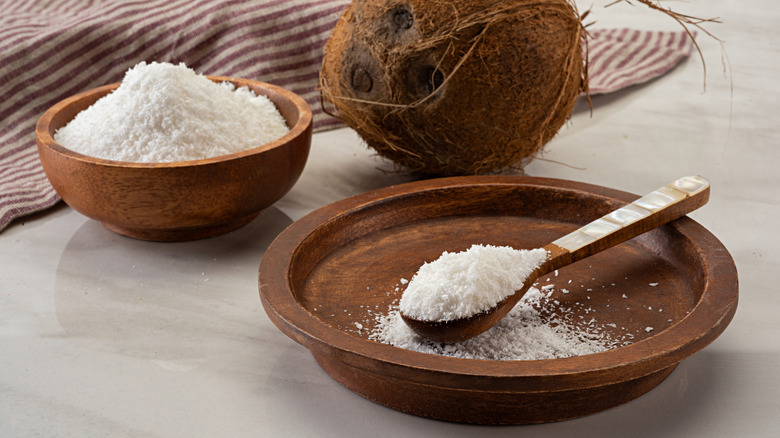Coconut Flakes Vs Shredded Coconut: How To Choose Between The Two
Coconuts are a fascinating kind of food. For one, they're a fruit, not a nut as the name suggests. Then, there's their unique composition; a hard shell encasing coconut meat and water. Unlike most fruit, this interior flesh contains a high fat content which can be pressed into virgin or refined coconut oil, or grated and blended into coconut milk. The meat can even be enjoyed on its own.
You may be most familiar with coconut flesh which has processed via desiccation; a type of dehydration that purifies the fruit and forms a shelf-stable solid. This version comes in several forms, with delicate coconut flakes and shredded coconut being two popular varieties. But choosing between the two foodstuffs can feel tricky. Both offer a rich flavor, brimming with the complex nutty sweetness that's characteristic of the fruit. But since it's processed into different sizes and textures meant for distinct applications, it's helpful to know the nuances for optimal use.
What are coconut flakes?
Coconut flakes — also referred to as coconut chips — are defined by a delightful crisp. Production starts with the coconut flesh, which is removed from the coconut and deskinned. The meat is then peeled into thin shreds that can stretch up to three inches long. To finish, the flakes are then slowly baked or dehydrated to eliminate much of their natural moisture.
Brilliantly white and prized as a garnish, coconut flakes offer a boldly nutty and sweet flavor that easily enhances a sweet or savory dish. Just take note that while they're initially crisp, coconut flakes soften up as they're exposure to moisture. Many chefs toast coconut flakes in order to accentuate the characteristically nutty profile. Heated on the stove or oven for as little as five minutes, the coconut quickly turns lightly brown and extra crisp.
What is shredded coconut?
Shredded coconut follows a production process similar to coconut flakes. The flesh from a more mature coconut is scooped out and the skin is removed. Then — in a move that separates these smaller bits from coconut flakes — the meat is shredded. The pieces contain a higher moisture and fat content than flakes, with a texture that can be further impacted by sweetening. The introduction of sugar enhances the product's sticky and moist nature, making it a fantastic option for desserts.
Whether shredded coconut is sweetened or not, this finely processed texture influences how you might use this variety. Shredded coconut can be folded into batter and dough, as well as readily blended and pureed, lending a rich coconut flavor without dominating any existing texture. Plus, shredded coconut offers a light texture which easily adheres to frosted baked goods, making it a typical pantry staple.
Texture separates coconut flakes and shredded coconut
These two types of coconut offer distinct features. The grain-like quality of shredded coconut leads to a soft, crumbly texture. Full of fat and moisture, it also readily integrates into liquids and batters. In addition to its characteristic flavor, shredded coconut lends chewiness to recipes like baked coconut donuts or chewy coconut chocolate chip cookies.
On the other hand, coconut flakes offer a staunch contrast. The flesh is crunchier and much bigger in size, making it more noticeable in dishes. Such a robust textural composition makes the flakes a sensational garnish, a go-to component in granola mixes, or an effortless dessert topping. For the best results, you won't want to substitute one type for the other, but rather use coconut flakes and shredded coconut for different purposes.
How to use shredded coconut and coconut flakes
The size and moisture content of shredded coconut makes it a favorite of bakers. The sweetened version can be found in coconut macaroons, coconut bread, or a coconut cream pie. It also adds wonderful flavor to a smoothie or a cream cheese cake frosting. The fluffy, bright white color makes shredded coconut an aesthetic garnish for cookies and lends a refreshing coconut flavor to a tres leches cake with a boozy rum kick. While unsweetened shredded coconut may appear in a curry or as a breading for crispy coconut shrimp, it might be best paired with desserts.
Meanwhile, crispier coconut flakes are a favorite for raw food recipes like coconut bacon, breakfast bars, granola bowl toppings, or trail mixes. Toasted coconut flakes shine in savory contexts, whether they top a salad or a chicken curry. The coconut flake imparts its satisfying texture and flavor to a wealth of dishes, making it a handy ingredient to store in your pantry.




